Star Trek - The Search for Spock
Synopsis
After the Enterprise has returned to Earth, Kirk gets a visit from Sarek. The Vulcan ambassador informs him that Spock's katra may still be alive. Since it does not reside with Kirk, the Admiral takes him to Starfleet Command. There they watch the surveillance tapes from the engine room that show the last moments of Spock's life. What they see is Spock doing a meld on McCoy right before he steps into the radiation poisoned dilithium chamber. Meanwhile, McCoy is threatening to go insane with Spock rattling around in his head. When the crew sets out to retrieve Spock's body from Genesis for the ceremony that would also save McCoy, they find more than they could ever have hoped for.
Pink Chairs and Painted Wings
Originally what was left of the Enterprise crew was supposed to have had a run in with some Romulans at Genesis (more). But the film's director admits to having a soft spot for the more juicier Klingons. In I Am Spock he states that he'd "always been more intrigued by the Klingons", though, in the DVD commentary Harve Bennett claims the idea for himself. The script underwent a rewrite, but the ship stayed the same: a Romulan Bird of Pray with painted wings and all, because the model had already been built at the time. While the reasons for that were budgetary concerns, the Bird of Pray turned out to become the trademark-ship for the Klingons in later movies. The transfer of technology was not entirely amiable, though. In an early version of the script the Klingon captain was supposed to have stolen it from the Romulans. But that never made it into the final film.
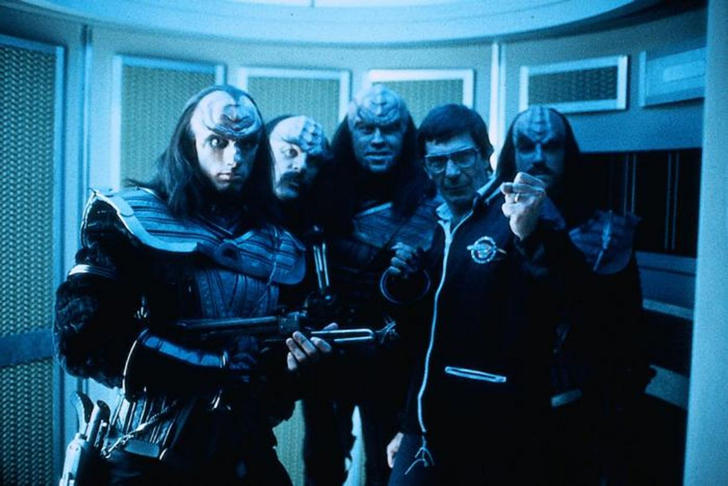 Just in case you were wondering why the USS Grissom
has pink chairs, Leonard Nimoy gives this explanation in the DVD commentary:
"the sense was that the Enterprise is the real thing, the rest
of them are sort of...poor imitations. I think the whole idea was
to make fun of this other, wonderful, advanced ship and put it in
competition with the Enterprise, the grand old lady who is still tough
and durable and feisty. The whole idea was to make this new ship effete
and therefore ridiculous."
Just in case you were wondering why the USS Grissom
has pink chairs, Leonard Nimoy gives this explanation in the DVD commentary:
"the sense was that the Enterprise is the real thing, the rest
of them are sort of...poor imitations. I think the whole idea was
to make fun of this other, wonderful, advanced ship and put it in
competition with the Enterprise, the grand old lady who is still tough
and durable and feisty. The whole idea was to make this new ship effete
and therefore ridiculous."
Actor Turning Director
Leonard Nimoy has been asked repeatedly in the past if he had been nervous how his fellow cast members were going to take it that he went from being their colleague to becoming their boss. He needn't have worried as far as Nichelle Nichols was concerned, it seems. She really brings out her love and admiration for him in her biography. With a healthy dose of irreverence mixed in as evidenced in an anecdote she relays from the shooting of Star Trek III:
Despite the hard work and long hours, being on a set with your friends brings out the kid in everyone. Well, almost everyone. The whole shooting of Star Trek III was a little surreal to begin with. Since Leonard had to direct Spock's scenes, he had to go back and forth between acting on the set and directing behind the camera, often in full costume. With all due respect to Leonard, how seriously can you take a director with pointed ears? One day, several of us, including Jimmy, Mark Lenard (who plays Spock's father, Sarek), and me, were standing around talking. We knew that Leonard was on the set nearby trying to establish a particularly difficult shot. Normally Leonard is unflappable, but the strain of acting and directing was beginning to show, and he was determined to keep the project on time and within budget.
We tried to keep our voices down, but then Dee arrived and told a stupid but hilarious joke about short men, full of double entendres. I know that most people think that anyone they see onscreen is very tall, so it comes as a shock for some when they see that actors are often shorter than they expect. In fact, upon meeting me, people often exclaim, "I thought you were six feet tall!" I always respond, "Well, Uhura is!" When we would film a shot that included George and Walter, I'd catch the two of them clowning around, each up on tiptoes, playfully trying to upstage each other by being "taller." Sometimes I'd join in, and we'd all laugh.
Anyway, George sauntered by and asked what was so funny. Dee repeated the joke. When George didn't get it immediately, Dee explained the punch line, which prompted one of George's bellowing, ruptured-goose laughs. By then we were all cracking up - at the joke, at George not getting the joke, at George's laughter - when who should come by but Walter. George told Walter the joke, then inadvertently insulted him by explaining the punch line. "I got it the first time," Walter said, bristling, before launching into an apparently serious tirade about how everyone picks on "the vertically impaired" and how wrong it is. By then the rest of us were out of control, howling, and George laughing loud enough to shake the rafters, oblivious of the work going on around the corner.
Suddenly: "CUT!!"
We stopped, looked at one another, and knew we were in trouble. Leonard, ears and all, came flying around the wall, cursing and screaming at us. It seems he had finally captured that crucial scene, but our laughter ruined the audio track and they had to reshoot. Like a bunch of guilty schoolkids, we took one look at our furious Vulcan director and scattered. All except Walter, of course, whom we left standing there mumbling to himself, "I don't see what's so funny about short men . . ." while George was reduced to tears, desperately trying to stop laughing.
 |
 |
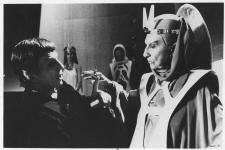 |
It has been mentioned in publications about The Search for Spock that a kind of shorthand for communication between the actors and their director developed, based on long years of knowledge of each other. In his book To the Stars George Takei gives an example of this:
Leonard's work as director was impressive - sure, disciplined, and indefatigable. He was acting, as well, albeit in an abridged role, so the energy demands on him for his two functions were killing. Where he found the strength to wake up in the middle of the night for his predawn makeup calls, remain so vital and creative on the set during the day, and still be able to do his homework after leaving late at night was an amazement to me. But he was always prepared and thoroughly organized. Uncannily like Spock.
But he was the polar opposite of Spock in the infectious joy he brought to his directing duties. I never saw Leonard smiling and laughing more. The work seemed to energize him. He used his relationship with each actor, built up over the years, as a special directorial asset. He communicated in a time-saving shorthand that comes only with years of professional rapport.
When I began one rehearsal by rushing onto the bridge, flinging off my leather cape with the flourish of a musketeer, he merely said quizzically, "George?" and subtly raised one eyebrow. That was all he needed to do. In the next one, I walked in briskly, slipped off my cape, and smartly slid into my seat at the console. Leonard smiled and nodded. On second thought, perhaps there was something Spockian about his directorial style after all. Minimal energy expended; maximum result gained.
Spock or Not Spock, That Is Not The Question
In the DVD commentary Harve Bennett jokingly says that ST III gave its Vulcan director an opportunity to show us his homeworld:
Interestingly enough, Nichelle Nichols, James Doohan, Walter Koenig, and George Takei have stated in the past that even they found it sometimes difficult to decide where Leonard Nimoy ended and Spock began. There is one clear demarcation line, though, as Nimoy discovered while directing the movie:
George Takei:
Over the years, I was to discover how fantastically original a creation Mr. Spock would become. So intriguing, so dense, and so elevating was this character that I often had difficulty distinguishing where the shared territory with the actor began and ended - where the borders might be that finally separated Mr. Spock from the profoundly complex man who came to personify him.
James Doohan:
I was down at California State University at Long Beach - I don't recall why - and Leonard was down there. I had heard that Leonard had told Paramount that he would not do the animated shows if Nichelle and George were not included. Paramount wanted to drop them from the show to save money. And Leonard, who had the clout to do so, told Paramount, "You put them in, or I don't do the show." That's the kind of guy Leonard is. And they were kept in, and that made everybody except the Paramount bean counters happy. In that respect, Leonard is much like Spock, because Spock would never let that sort of thing happen, either. But Leonard's not one to make a scene about it. He's contained. If he doesn't want to do something, he doesn't do it.
Walter Koenig:
11:18 a.m.: On the soundstage [of Star Trek The Motion Picture]. Leonard sits down in a nearby chair. It occurs to me while we are talking that I have never spoken to him at sufficient length to determine whether the somewhat taciturn and sober presentation he makes is nine parts Spock or nine parts Nimoy. I am only sure that the character he plays is a wonder to behold. I find myself as Chekov being comforted by his presence. It is a mark of Leonard's command of his portrayal that when I step onto the set and assume the Russian identity I have immediate well-defined feelings about the Vulcan across from me. How bad can wormholes and whiplash energy bolts be when they don't seem to ruffle our science officer? I have concluded, therefore, that when I take that airplane flight where the motors fall off and we drop like a bucket from the sky, I want Spock beside me saying, "Interesting." Whether I'd settle for Leonard Nimoy in those circumstances is the point of my original question, vis-a-vis to what degree are the actor and the character he plays the same person. I know that Leonard has written a book with a title that apparently defines his feelings on the matter, but I also know that when we perform roles truthfully (and there isn't a false note in the character of the Vulcan), we draw upon ourselves for the source material. The person we play may not be the face we show the world out of makeup, but, nonetheless, the germ of that being is tucked away inside us somewhere waiting to be liberated, waiting for license (the script and the camera) to develop and give itself expression. I guess, then, that even without any telling statement from him in our conversation, I have answered my own question. Even if the qualities of the Vulcan are not operational in Leonard's everyday life, they are an organic part of him. Spock-Nimoy are a compound, not a mixture, and cannot be separated.
Leonard Nimoy:
Spock: (with a flicker of repressed joy) Jim. Your Name is Jim
Kirk: Yes, Spock! Yes.
The scene ends with the crew happily gathering around their Vulcan friend to welcome him back. As director, I encouraged them all to embrace Spock - if they could. Interestingly, while all their faces clearly shone with joy, not one of them dared hug the Vulcan (although Nichelle Nichols did reach out warmly toward me, and De Kelley eased any tension by smilingly tapping his skull, as if to say, "Remember my friend? You were a tenant here..."). I guess you just don't grab Spock!
This is of course not because they confuse the actor with the character, an accusation sometimes directed at fans, but because Mr. Nimoy invested a lot of himself into the character. Spock became a connoisseur of art certainly not by accident in Star Trek: The Undiscovered Country. It seems safe to assume that the actor's own interests in the subject influenced the development of the character heavily. In the DVD commentary Harve Bennett also mentions that "There is a lot of Vulcan that is Hebraic," and that Leonard who "is a student of all things brought a little of that".
Shades of Shekina?
Ever since I saw The Search for Spock for the first time something bothered me about the maidens that carried Spock's body up to Mount Seleya. Something about their flimsy attire at first sight more reminiscent of temple whores than what one has come to expect of Vulcan fashion did not sit right with me. Then Mr. Nimoy published his book Shekina, in which he described what in that religion is known as the female essence of the Jewish god or to denote that god's presence. At about the same time I found a publicity still from ST III where the maidens were backlit in a way that reminded me of photos from Shekina I had seen. Whether or not Mr. Nimoy already meant to implement that concept in the film in some way, consciously or unconsciously, can only be speculated on. But at least the choice for the women's apparel finally began to make some sense to me.
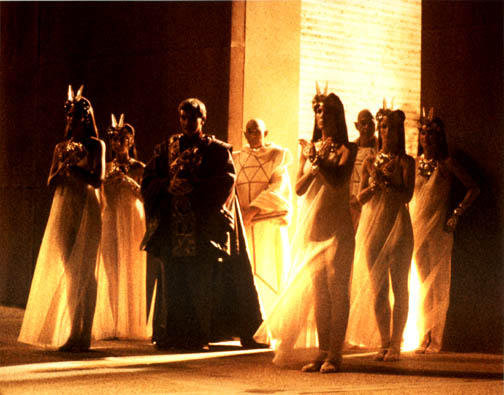 |
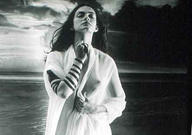 |
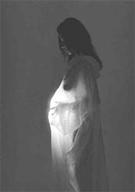 |
On further reading up on the subject I happened on the goddess Asherah, who in the distant past was worshipped side by side to Jahwe and believed to be his wife. Asherah herself is believed to have been derived from older images of female deities and to be an incarnation of a divine concept that was worshipped under different names in different cultures and time (Ishtar, Astarte, Aphrodite, Venus):
"In addition to biblical evidence for the prevalence of goddess worship among the Israelites, further confirmation may be derived from the archaeological data. Hundreds of terra-cotta plaques and figurines of nude female figures have been found throughout Palestine. Some are figures of pregnant women, others are pillar-like figurines showing a female figure from the waist up with a cylindrical base below. Those found in the Northern Kingdom are more naturalistically styled than the ones from Judah, possibly due to the Phoenician artistic influence. In Israel the figure’s hands hold her breasts - or sometimes a round object, possibly a tambourine. In Judah the pillar figure, again usually with the hands to the breasts, was more common, and the finest examples of these were found in Jerusalem, dating from the 8th and 7th centuries (Mazar 1990: 501-02). There can be no doubt that these figurines played a prominent role in daily religious practice, but it is still an open question as to whether they represented the goddess herself, a priestess of the goddess, a cultic prostitute, or were talismans used in sympathetic magic to stimulate the reproductive processes of nature" (The complete treatise can be found here).
In interviews Mr. Nimoy has mentioned that in preparation for his book "Shekina" he had also read up on Kabbalistic believes (go here for the jewsweek interview) among others and for me personally his photography seems to reflect some of those and even older concepts of female divinity of the culture that he was born into and has made artistic use of. After all, no matter how fantastic the aliens seem that the imagination of writers and movie making can come up with, they are always firmly grounded in our own earthly experiences. In the absence of truly having met extraterrestrial life forms, that is the only thing that we can extrapolate from. (There is even a life form on this planet who's blood chemistry is based on copper: the horseshoe crab. Unlike green Vulcan blood hemocyanin is gray-white to pale yellow, though, and when it comes into contact with air turns blue according to the animal's entry in the Wikipedia.)
Vulcan seems to show signs of matriarchal overtones if one looks at the figures of prominence in TOS and the movies as there are T'Pau, the Kolinahr High Master and T'Lar. If that be the case, with the movie director's background, preferred spiritual believes and bringing a lot of himself to Star Trek, falling back on this kind of imagery makes sense.
Vulcan Lost
Had it been possible, Leonard Nimoy would have liked to show more of Spock's journey up the steps of Mount Seleya as he explains in the DVD commentary. Some concept art drawings of what could have been can be found in The Art of Star Trek and the DVD's special features:
There was a lot of stuff I wanted to do on that walk up the stairs that I couldn't get. I wanted to get more in touch with the people. I wanted to get in touch with people's reaction to Spock, this legendary person coming home. I don't know if you can see it or if you were ever aware of it, but when those women were carrying the body I have them simply holding their hands over Spock's body, not under Spock's body but over Spock's body, as though they were levitating him, did you notice that? I tried everything. I tried all kinds of strange magical touches here. The magic of Vulcan - I always felt I had a big responsibility to try to enhance the magic of the Vulcan people, the Vulcan planet. Spock was an important person on the Vulcan planet, and he had died, and now word comes out on the planet that Spock is coming home, and there's gonna be this katra ritual that hasn't been done in ages and to try to save Spock. It was to me a very big culminating scene. And I wanted big acting, I wanted big sets, I wanted a lot of people, I wanted maybe three or four times as many people as we could afford.
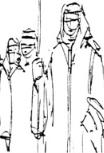 |
 |
 |
 |
 |
 |
Promoting Star Trek III on German TV
Leonard Nimoy said the first time around he came to Germany (I assume he is talking about promoting Star Trek III) he hadn't a good time (see Stars of David), something his second visit, this time to Fed Con in 1999 made more than good on. Being the professional he is, though, the audience wouldn't know any better. I certainly wouldn't have guessed from watching him on our talk shows at the time. Not to mention that I had been reduced to a brainless puddle of fan-girl goo after seeing the clip with Spock saying, "Jim. Your name is Jim," anyway.
Here are two of his appearances on Auf Los Geht's Los and Die Aktuelle Schaubudeand his arrival at the airport plus interview, and a piece about him on an entertainment magazine, Bitte Umblättern, that was done at his home.
Making Of
In 1982 Leonard Nimoy became the host of a children's program on Nickelodeon, Standby... Lights! Camera! Action!, that explained to its young audience how movies get made. One show in 1984 was devoted entirely to the making of The Search for Spock, in which George Takei appeared as a guest. So let's hear what those two have to say about the movie. Also, from a convention there is Robin Curtis recollecting some funny moments about filming ST III. She tells the same story in the special features on the DVD, but her telling it here is much more animated. Also, did you know Leonard Nimoy, credited as Frank Force, is the voice of the turbolift on the Excelsior?
|
|
|
|
|
|
|
|
|
|
|
You know the drill. More here, since otherwise this page would blow out of proportion.
Bibliography
Doohan, James and Peter David, Beam Me Up Scotty, Pocket Books, London, 1996, p. 186-187.
Long, Asphodel P., The Goddess in Judaism - An Historical Perspective, http://www.asphodel-long.com/html/goddess_in_judaism.html, 1991.
Koenig, Walter, Chekov's Enterprise, Pocket Books, New York, 1980, p. 109-110.
Muntean,Fritz, Asherah: Goddess of the Israelites, http://pagantheologies.pbwiki.com/f/Asherah_Article .pdf, 2000.
Nichols, Nichelle, "Beyond Uhura", Boxtree, London, 1995, p 260-261.
Nimoy, Leonard, "I am Spock", Century, London, 1995, p. 223 & 240.
Reeves-Stevens, Judith and Garfield, "The Art of Star Trek", Pocket Books, New York, 1995, p.215-219 .
Takei, George, To the Stars, Pocket Books, London, 1994, p. 230.
Wikipedia, Horseshoe crab, http://en.wikipedia.org/wiki/Horseshoe_crab, 01/2007.

